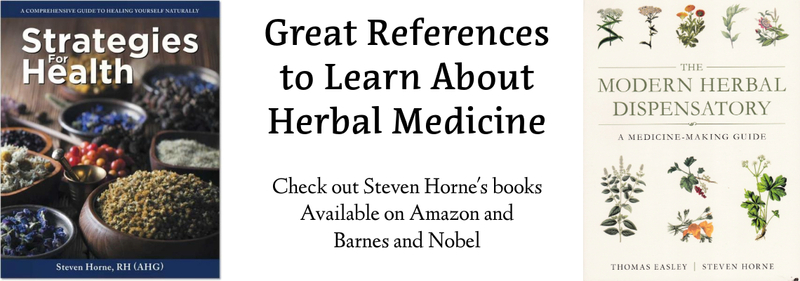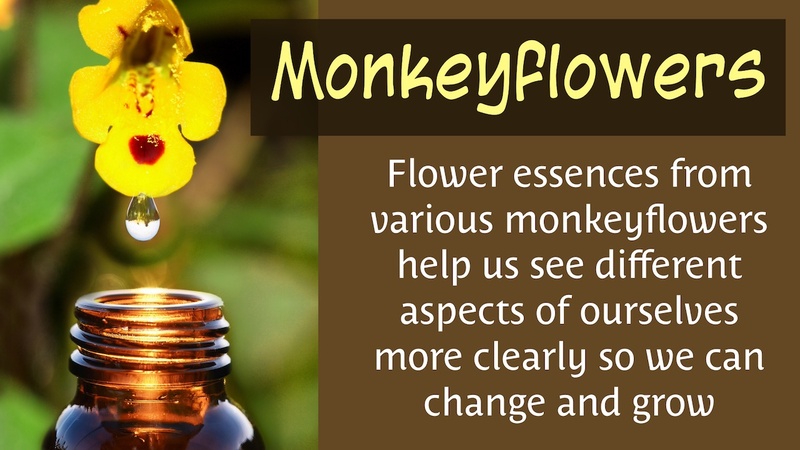
While exploring the outdoors, I've enjoyed encountering various species of monkeyflowers. These monkey-faced flowers are often found growing in moist places near streams and lakes. They are edible and I've snacked on them often. They tend to have a salty flavor as they readily take up sodium chloride from the soil. They may also be slightly bitter. They probably have a mild lymph-moving and alterative effect, even if you won’t find them mentioned as a medicinal plant in herb texts.
However, I'm most interested in discussing the emotional healing aspects of monkeyflowers. I recently wrote about two herbs for the eyes: eyebright and bilberries. Both of these plants can help us see the world better, but monkeyflowers can help us interpret the world with better emotional clarity.
What we see isn’t determined just by the light entering our eyes; it’s also determined by what our brains choose to bring to our consciousness. Thus, our inner emotional state and existing beliefs filter what we see, only acknowledging what conforms with our existing interests and biases and ignoring or even rejecting what does not.
Monkeyflowers as Tools for Inner Sight
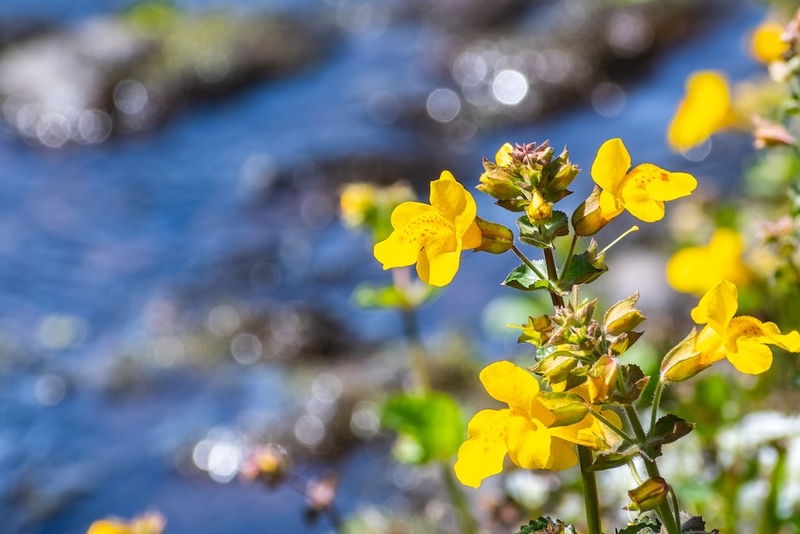 One of the greatest obstacles in self-improvement is being able to see ourselves clearly. Change requires accurate self-reflection, the ability to look at ourselves objectively and examine issues like, “Why do I think that way?” and “Why did I do that?” Self-awareness, that is the recognition that “I have a problem,” is the first step to discarding self-destructive thoughts and habits and creating beneficial ones.
One of the greatest obstacles in self-improvement is being able to see ourselves clearly. Change requires accurate self-reflection, the ability to look at ourselves objectively and examine issues like, “Why do I think that way?” and “Why did I do that?” Self-awareness, that is the recognition that “I have a problem,” is the first step to discarding self-destructive thoughts and habits and creating beneficial ones.
Other people can share their observations, but because of innate internal bias, this often makes us defensive leading us to reject the viewpoints of others in favor of our own internal way of seeing things.
That’s where monkeyflowers are useful remedies. They help us see ourselves more clearly. Their association with monkeys is because many species have an appearance that resembles a face, specifically, one that is sticking out its tongue. We often stick out our tongues to suggest silliness or disgust.
My general view of monkeyflowers is that they help us put up a kind of inner mirror that allows us to not only see aspects of ourselves that we may be denying, but also to not take ourselves too seriously about these issues. Instead, we can sort of “stick out our tongue” at ourselves and “monkey around” with making appropriate changes. Another way of putting this is that they help us lighten up while seeing things about ourselves that maybe we don’t want to see.
A Little Botany
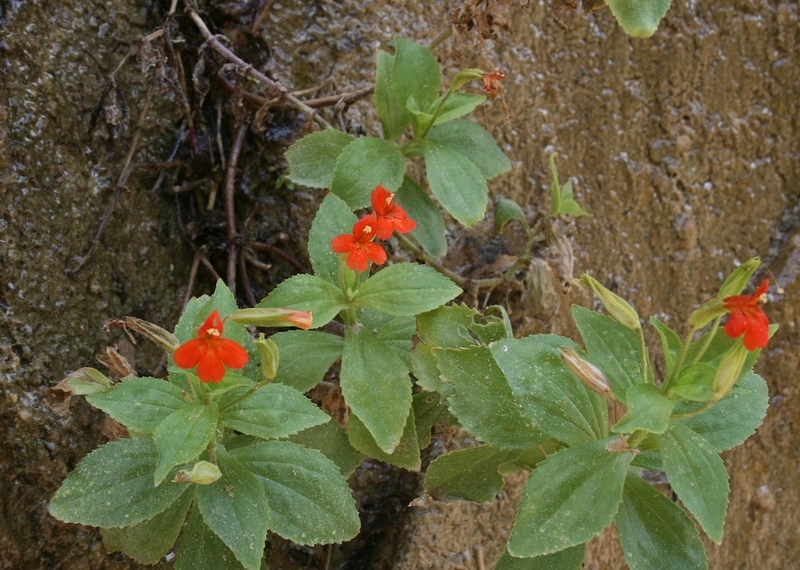 Traditionally all of these plants were in the genus Mimulus and part of the Figwort family. The Latin name Mimulus comes from the word mimic, which is associated with monkeys, as in “monkey see, monkey do.” But because of advances in genetic fingerprinting most of these remedies have been moved to the genus, Erythranthe, which is in the Phrymaceae (or lopseed) family. Two have been moved to the genus Diplacus, in the same family. Regardless of the genetic classification here are the emotional uses of five monkeyflowers.
Traditionally all of these plants were in the genus Mimulus and part of the Figwort family. The Latin name Mimulus comes from the word mimic, which is associated with monkeys, as in “monkey see, monkey do.” But because of advances in genetic fingerprinting most of these remedies have been moved to the genus, Erythranthe, which is in the Phrymaceae (or lopseed) family. Two have been moved to the genus Diplacus, in the same family. Regardless of the genetic classification here are the emotional uses of five monkeyflowers.
Mimulus (Yellow Monkeyflower)
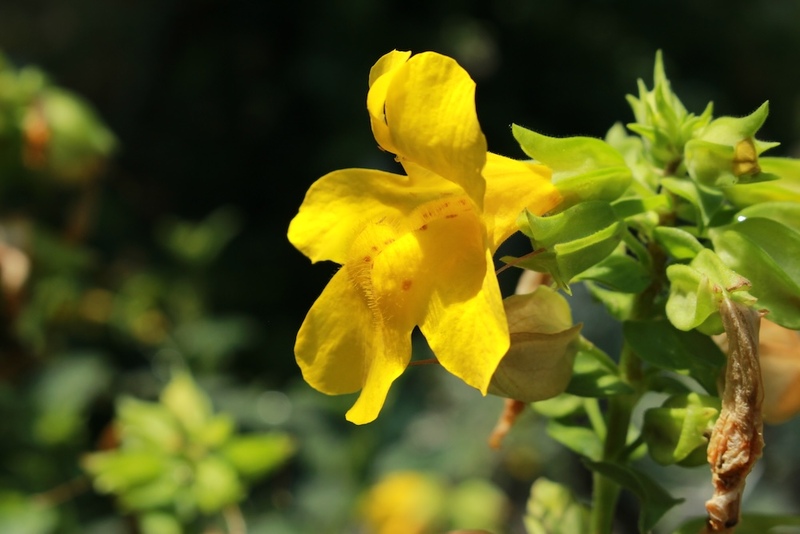 Mimulus is one of the original 38 Bach flower remedies. Made from the flowers of Erythranthe guttata (formerly Mimulus guttata) which was introduced from Europe into the Americas and is now extremely common in North America. I’ve seen it growing by streams many times and taken photos of it.
Mimulus is one of the original 38 Bach flower remedies. Made from the flowers of Erythranthe guttata (formerly Mimulus guttata) which was introduced from Europe into the Americas and is now extremely common in North America. I’ve seen it growing by streams many times and taken photos of it.
The yellow color of Mimulus gives us a clue as to the emotion it helps us face—fear. Mimulus helps us look more objectively at things we know we are afraid of, such as snakes, spiders, heights, flying, crowds, or public speaking, and confront and transform those fears. Fear is overcome by courage, which involves taking action in the face of what we fear and mimulus helps us have that courage to confront things we fear and learn to rise above those fears.
While there are some valid things to fear, most of our fears don’t involve anything genuinely life-threatening. As children, we are naturally courageous; we readily try new things, but parents and other influential adults often instill irrational fears into us. These fears continue to control our behavior as adults and often prevent us from pursuing the goals we’d like to achieve. Mimulus is the monkeyflower that can help us acknowledge the irritational nature of these fears so we can challenge and overcome them.
Scarlet Monkeyflower
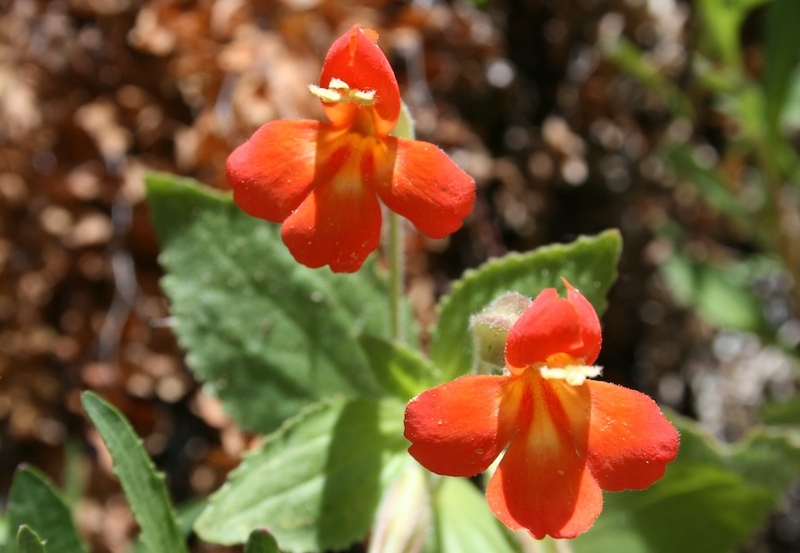 Erythranthe cardinalis is a remedy I’ve used with many people, including myself. Again, the color of the flower gives a clue as to the aspect of self this monkeyflower helps us face. Scarlet is the color associated with lust and anger, and people who need this remedy are often afraid to face these strong, base emotions. They tend to suppress or deny feelings of anger or sexual desire, which may cause these feelings to come out in negative ways.
Erythranthe cardinalis is a remedy I’ve used with many people, including myself. Again, the color of the flower gives a clue as to the aspect of self this monkeyflower helps us face. Scarlet is the color associated with lust and anger, and people who need this remedy are often afraid to face these strong, base emotions. They tend to suppress or deny feelings of anger or sexual desire, which may cause these feelings to come out in negative ways.
One of these is the inability to set appropriate boundaries or to manifest sexual desire positively. If you can’t acknowledge your desires or anger, you may become a doormat for others, giving into their angry demands while suppressing your own needs and wants. In some people, these emotions are transformed into other emotions, particularly grief and helplessness as a vent for them.
When someone shares an experience with me while I'm doing emotional healing work with them, I like to ask, “And how did that make you feel?” Many times, they’ll say it made them feel angry, but when I ask them to get in touch with that anger and express it, they often burst into tears instead. When that happens, I combine scarlet monkeyflower with another remedy, fuchsia flower essence, which helps people who are transforming one emotion into another. This will help them connect with and express their anger rather than remaining stuck in feeling helpless and hopeless.
Pink Monkeyflower
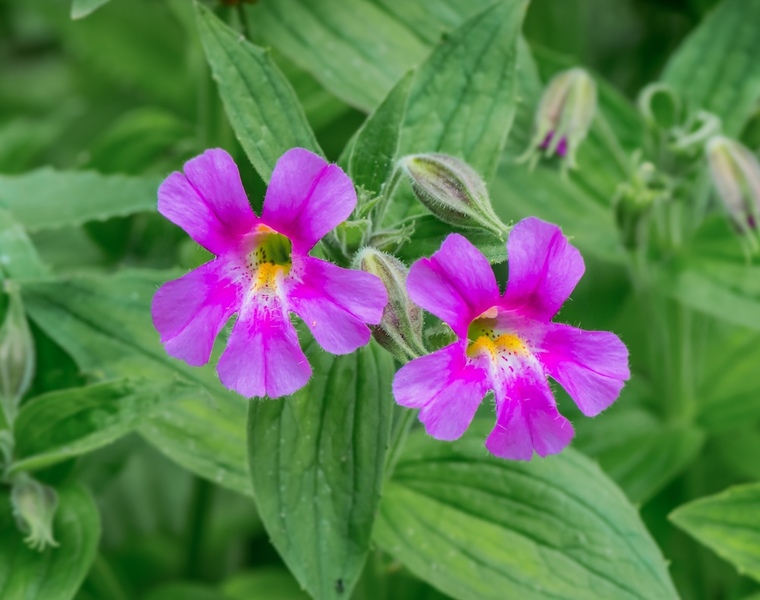 Erythranthe lewisii is a pink-colored monkeyflower that helps people reconnect with their innocence. Again, the color gives a clue as to the aspect of self that needs to be seen. Pink is associated with innocence, especially the innocence of the newborn baby.
Erythranthe lewisii is a pink-colored monkeyflower that helps people reconnect with their innocence. Again, the color gives a clue as to the aspect of self that needs to be seen. Pink is associated with innocence, especially the innocence of the newborn baby.
Because of abuse or as a result of past mistakes, some people are unable to see their innocence. They look inside and experience shame, guilt, fear, and feelings of unworthiness. They want to hide the abuses or mistakes of their past behind a mask, pretending everything is alright. They fear exposure and the rejection they believe will come with it. Their fear of being seen emotionally may even result in fear of being seen physically or touched by other people, even in simple, friendly ways, such as a handshake, hand on the shoulder, or pat on the back.
Pink monkeyflower helps a person to see their innocence and self-worth. It helps them understand they don’t need to be ashamed of past abuse and can move forward, letting go of past problems and mistakes. This helps them feel more confident in taking emotional risks with others. It helps them be more emotionally open and honest.
This is an important step in emotional healing for many people. I think it’s a broad issue with the human experience. Many of us are raised with a lack of acceptance for who we are. So, we put on a mask, trying to gain acceptance or approval. The show we put on may get us some recognition or approval, but inwardly we are unable to accept it. We recognize that people are only loving the mask we’re wearing, not the imperfect human being behind it. This leads to a superficiality and shallowness in our relationship with others.
Intimacy requires exposure, which requires trust. The more open we can be with someone and find they still accept us, the deeper the intimacy we will have with that person. But we also know that if we act more genuinely and expose our honest feelings, we might lose friends or face rejection by people close to us. When we drop our masks, those who only loved our masks will desert us. Ultimately, when we are genuine, the people we will attract will be those who love us for who we really are, resulting in fewer, but deeper friendships than we previously experienced.
Sticky Monkeyflower
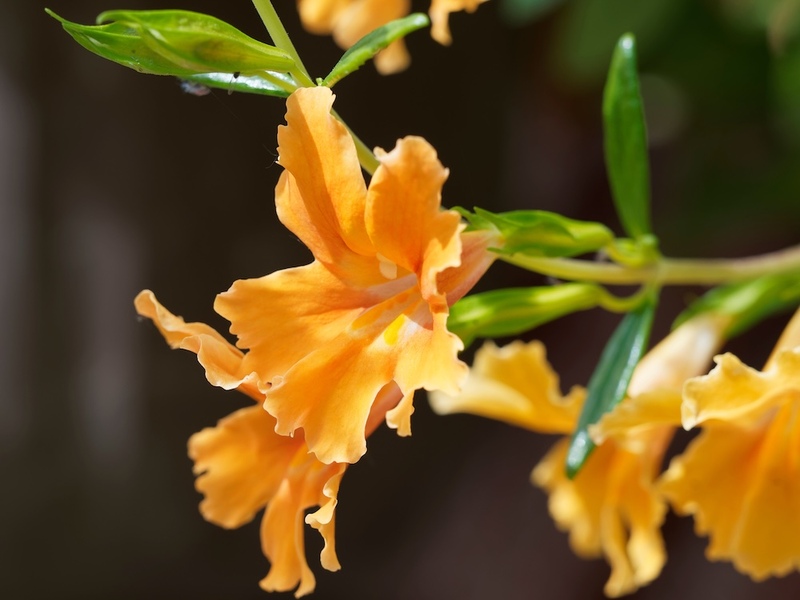 Diplacus aurantiacus, the sticky monkey-flower or orange bush monkey-flower addresses an issue that pretty much all of us face as teenagers. As we enter puberty, the sexual desires we feel can be confusing and frustrating. Hopefully, we work through these issues and eventually develop a healthy attitude about sex.
Diplacus aurantiacus, the sticky monkey-flower or orange bush monkey-flower addresses an issue that pretty much all of us face as teenagers. As we enter puberty, the sexual desires we feel can be confusing and frustrating. Hopefully, we work through these issues and eventually develop a healthy attitude about sex.
However, this doesn’t always happen. Because of sexual abuse, sexual shaming, and social conditioning, we may be unable to find a healthy way to deal with our sexual feelings. Part of the problem we face is that having sexual relationships creates pleasurable feelings, but it also opens us up to equally painful emotions, too. Being betrayed by a sexual partner, for example, can be emotionally devastating. Sticky monkeyflower helps us look at our sexual desires and discover how to use them in a healthy way.
A person who has dysfunctional beliefs about their sexuality will typically go one of two directions. They may feel that sex is dirty or even evil and thus fear and avoid sexual intimacy, even with a marriage partner. But they may also go in the opposite direction. Instead of creating a deep bond with one partner, they may have short, shallow, and superficial sexual encounters with many partners.
In today’s “hook-up” culture, many young people seem unable to form a lasting or happy marriage or partnership with another person, winding up instead with a “high body count” of previous “lovers.”I see many young people who have difficulty in forming a lasting or happy marriage or partnership with another person. So, I think this remedy may also be widely needed to help people face and understand their sexuality on a deeper, spiritual level, connecting it with partnership, genuine love, and the formation of strong family bonds, instead of a shallow, temporary expression of these biological urges.
Purple Monkeyflower
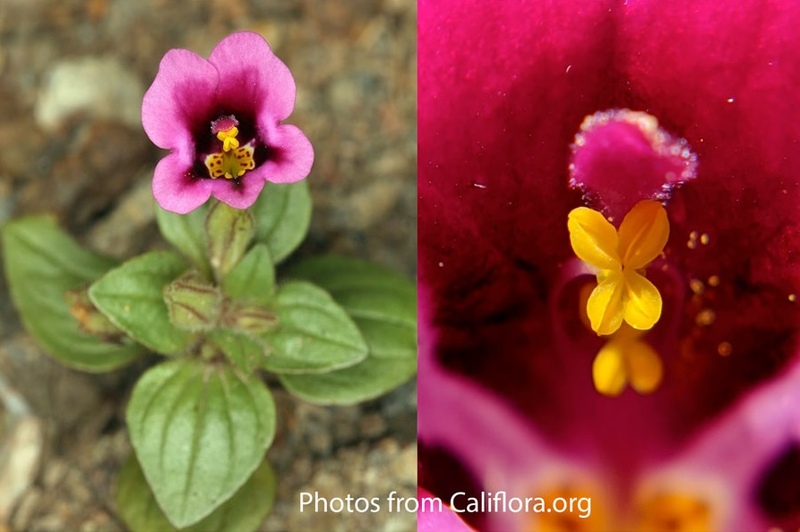
Purple monkeyflower helps people who have dissociated parts of themselves reconnect and integrate. This has been an important flower essence for me because it has been a vital tool in the emotional healing work I've done with people who have been ritualistically abused.
Ritualistic abuse isn’t done by people with out-of-control emotions, such as losing one’s temper and harming someone in the process, or having uncontrolled sexual desires and using sex to violate another person's boundaries to satisfy one's desires. Instead, ritualistic abuse is a cold and deliberate effort to cause pain and trauma.
In my experience, ritualistic abuse leads to disassociation. Dissociation is something I’ve encountered many times while working with people who have been abused. They describe leaving their body and looking down on the abusive situation like a person having a near-death, out-of-body experience.
Severe and frequent abuse can cause a person to develop Dissociative Identity Disorder (DID), formerly known as multiple personality disorder. The medical explanation for this is that the brain learns to compartmentalize these memories to suppress the painful memories of their experiences.
Based on working with victims of ritualistic abuse, I have a different take on this problem. I believe that when a traumatized person leaves their body, they are open to possession by other spiritual entities. These other spirits have their own personalities and share the body of the victim.
But whether you believe these different personalities are just subpersonalities of the same soul or the possession of many different souls, the goal of healing is the same. The person needs to “come back together” and be made whole.
Reintegrating after this kind of abuse is not an easy process because it requires facing and working through what happened. This is where purple monkeyflower has been helpful.
Diplacus kelloggii looks like an opening into a dark throat, which suggests it helps a person penetrate the darkness within and bring in the light. I always use it with people who have been the victims of ongoing or ritualistic abuse.
The purple color suggests to me that it helps us reconnect with what some people call the higher self. It can help a person face what happened to them and either re-integrate their personality or retake possession of their own body. I know that this is heavy stuff, which is why it is so important to know if you ever encounter this.
Summary
As you can see, monkeyflowers can help give us insights into the parts of us that we might overlook or want to ignore. This in turn can help us reconnect and change ourselves for the better. With about 120 species in the Erythranthe genus and about 49 species in the Diplacus genus I think we’ve only scratched the surface of the issues monkeyflowers may be able to help us face. Hopefully, we’ll discover uses for many other species in the future.
Steven's Articles
-

-
The Health Benefits and Problems with Coffee
This popular caffeinated beverage can be beneficial…
October
-

-
Understanding Caffeine & Cellular Adaptation
Preserving the power of caffeine's buzz and the…
September
-

-
Horseradish
A pungent spice for aiding protein metabolism…
-

-
Banaba or Crepe Myrtle
A beautiful tree from Southeast Asia whose leaves…
August
-

-
Monkeyflowers
Flower essences to help see ourselves more clearly…
-

-
Mariposa Lilies
Strengthening the bond between mother and child…
-

-
The Noble Bay Leaf
A common kitchen herb for aiding digestion and…
-

-
Epimedium: Horny Goat Weed
A circulatory stimulant and kidney yang tonic…
July
-

-
The Medicinal and Nutritional Benefits of Apricots
A nutritious fruit and valuable medicinal seed for coughs
-

-
Dogwoods
Asian dogwood is used to stop excessive discharge,…
June
-

-
Neem: The Village Pharmacy
A popular Ayurvedic remedy for dental and immune…
-

-
Spilanthes: The Toothache Plant
A traditional remedy for teeth and gums, as well…
-

-
Forsythia
An anti-inflammatory, fever-reducing, and infection fighting herb
May
-

-
Buckwheat (Kashi)
A delicious, high protein, gluten-free, gut-healthy food
-

-
Leaky Gut Syndrome
Plugging the leaks on the underlying cause of…

